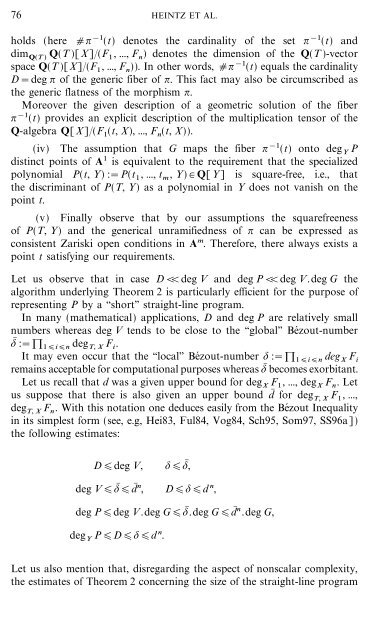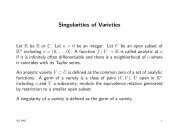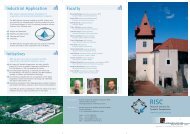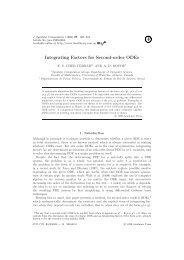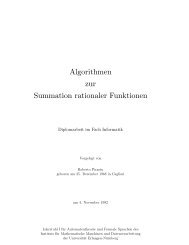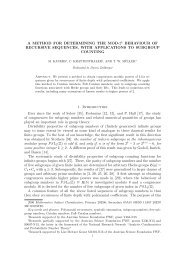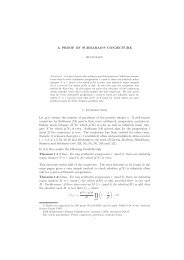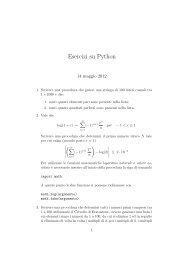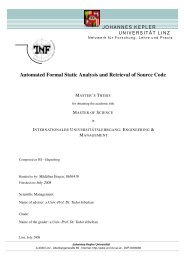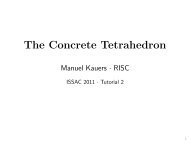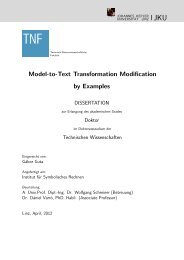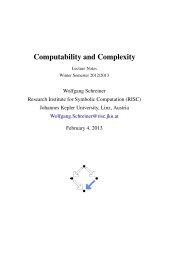DEFORMATION TECHNIQUES 75 vanishes on each image point of this map and, <strong>for</strong> a generically chosen point { # A m , exactly on them. Moreover, since the polynomial P(T, Y) is monic in Y, we have P({, Y){0 <strong>for</strong> any parameter point { # A m . In this sense, the elimination problem we are considering (namely that of finding a straightline program representation <strong>for</strong> the polynomial P starting with the given data F 1 , ..., F n , G, t and ? &1 (t) isofparametric nature. How do we proceed if our task is to find <strong>for</strong> an arbitrarily given parameter point { # Q m a description of a geometric solution of the zero-dimensional variety defined by the equations F 1 ({, X), ..., F n ({, X)? In this case we choose a generic linear <strong>for</strong>m U :=* 1 X 1 +}}}+* n X n of Q[X 1 , ..., X n ] and compute solutions <strong>for</strong> the 2n specific problem instances F 1 ({, X), ..., F n ({, X), X i and F 1 ({, X), ..., F n ({, X), U&* i X i , where 1in. From these solution polynomials we compute now easily a description of the geometric solution of the polynomial equation system F 1 ({, X)=0, ..., F n ({, X)=0 applying the algorithms subjacent to [KP96, Lemma 26, Proposition 27, and Theorem 22]. In order to enlighten the long list of assumptions <strong>for</strong> our input equation system in Theorem 2, let us comment here some of its aspects: (i) Under the assumption that V is equidimensional and that ? is finite and surjective, the condition of ? being generically unramified in the scheme-theoretical sense is equivalent to the requirement that the polynomials F 1 , ..., F n span a radical ideal in Q(T )[X]. Thus, under the assumptions of Theorem 2, if F 1 , ..., F n <strong>for</strong>m a regular sequence in Q[T, X], it turns out that the ideal (F 1 , ..., F n ) is a radical ideal of Q[T, X]. (ii) As the image of ?~ is an hypersurface of A m+1 , its minimal polynomial P(T, Y) is well defined. Since Q is a perfect field, the minimal polynomial P(T, Y) is square free and since the morphism ? is finite, P(T, Y) is monic in Y. The polynomial P(T, G) vanishes on the variety V and belongs to the ideal spanned by F 1 , ..., F n in Q(T )[X]. Moreover, if F 1 , ..., F n is a regular sequence in Q[T, X], the polynomial P(T, G) belongs to the ideal spanned by F 1 , ..., F n in Q[T, X]. (iii) The assumption that the given parameter point t=(t 1 , ..., t m )# Q m has a scheme-theoretically unramified fiber ? &1 (t) means that the specialized ideal (F 1 (t, X), ..., F n (t, X)) is radical in Q[X]. This, in turn, implies that the fiber ? &1 (t) contains only smooth points of the variety V, having regular local rings. Thus, the semilocal ring Q[T] (T1 &t 1 , ..., T m &t m )[X](F 1 , ..., F n ) is CohenMacaulay and from the finiteness of ? we deduce that *? &1 (t)=dim Q(T ) Q(T )[X](F 1 , ..., F n )
76 HEINTZ ET AL. holds (here *? &1 (t) denotes the cardinality of the set ? &1 (t) and dim Q(T ) Q(T )[X](F 1 , ..., F n ) denotes the dimension of the Q(T )-vector space Q(T )[X](F 1 , ..., F n )). In other words, *? &1 (t) equals the cardinality D=deg ? of the generic fiber of ?. This fact may also be circumscribed as the generic flatness of the morphism ?. Moreover the given description of a geometric solution of the fiber ? &1 (t) provides an explicit description of the multiplication tensor of the Q-algebra Q[X](F 1 (t, X), ..., F n (t, X)). (iv) The assumption that G maps the fiber ? &1 (t) onto deg Y P distinct points of A 1 is equivalent to the requirement that the specialized polynomial P(t, Y) :=P(t 1 , ..., t m , Y)#Q[Y] is square-free, i.e., that the discriminant of P(T, Y) as a polynomial in Y does not vanish on the point t. (v) Finally observe that by our assumptions the squarefreeness of P(T, Y) and the generical unramifiedness of ? can be expressed as consistent Zariski open conditions in A m . There<strong>for</strong>e, there always exists a point t satisfying our requirements. Let us observe that in case D


